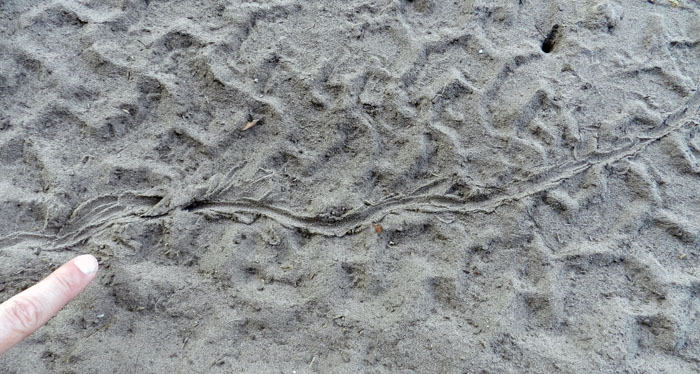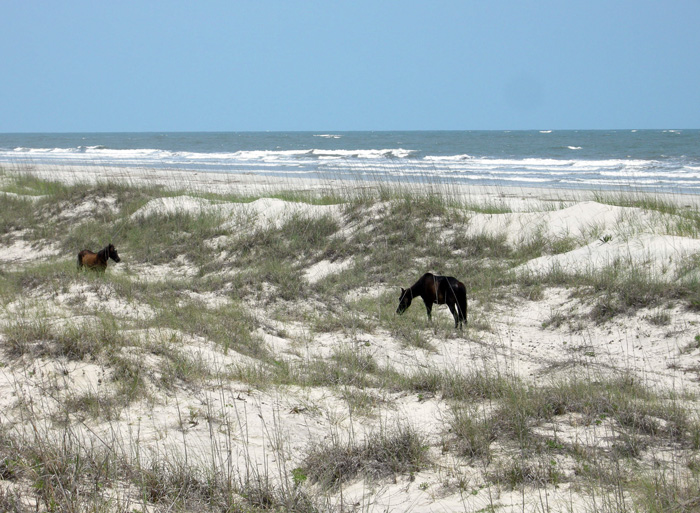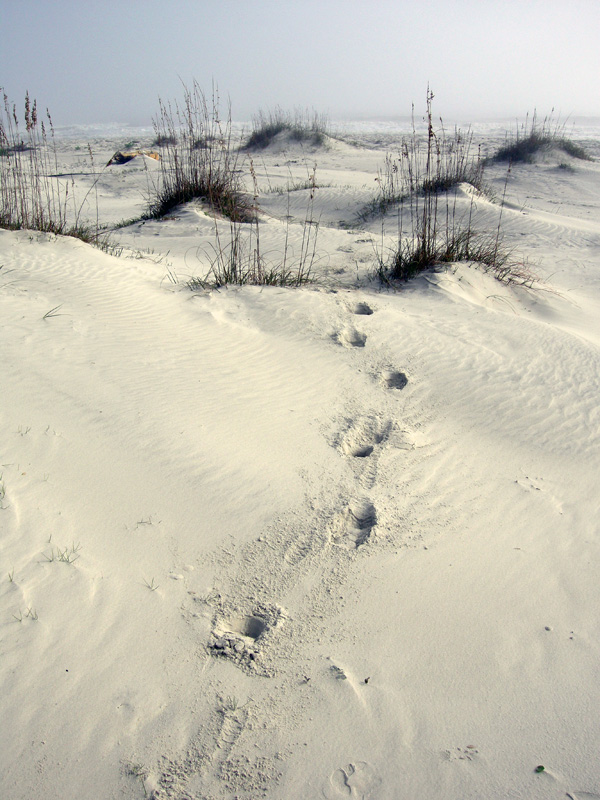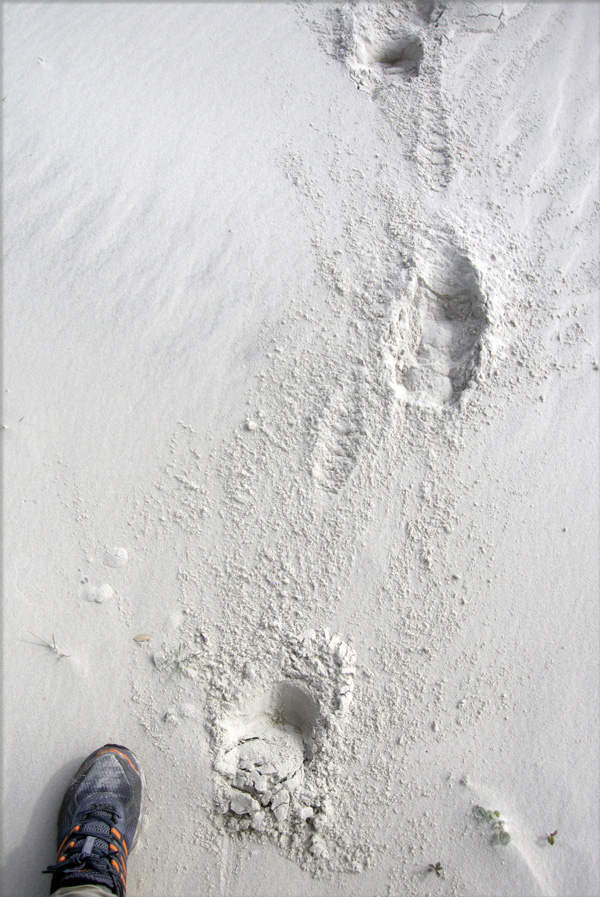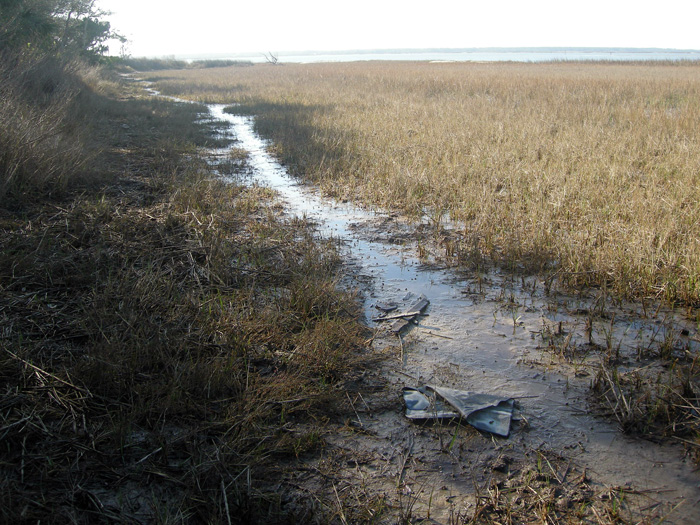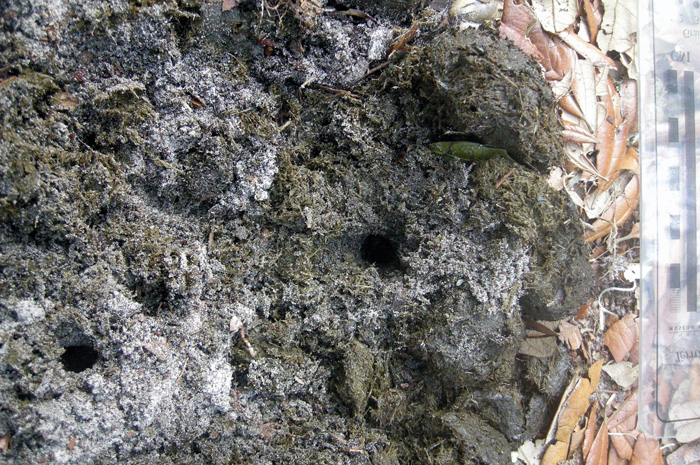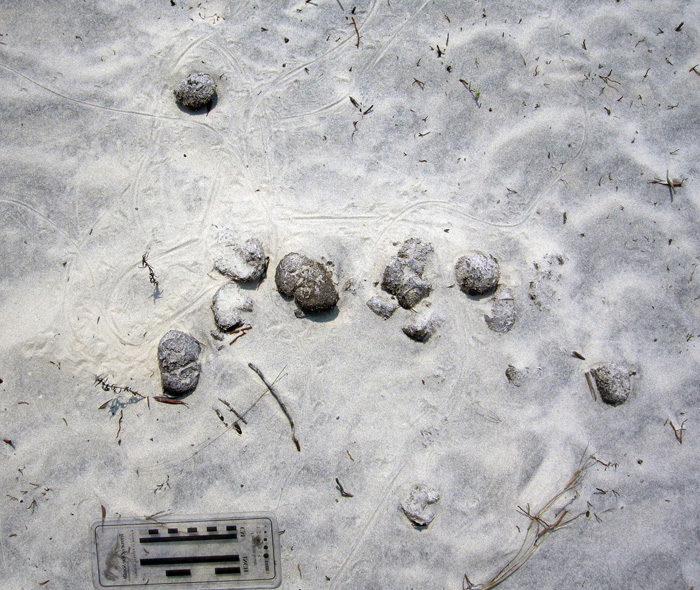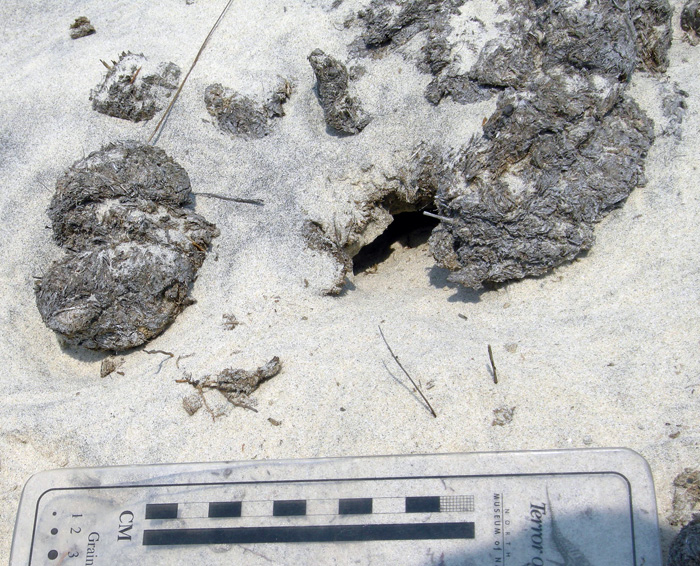Every time I visit the Georgia coast, traces that have been there all along make themselves apparent to me for the first time. One would think these personal discoveries would stop happening after more than fifteen years (on and off) of going to that coast and studying its traces, especially after writing a 700-page book about them (Life Traces of the Georgia Coast). Nevertheless, they happen, and when they do, these insights underscore the importance of doing regular field work in the same places. However familiar it might seem, there’s always something different you missed previously while there. So before each trip to the Georgia coast, I make sure to become wide-eyed and expectant, rather than jaded and bored.
 Mysterious trails in a sandy road, crossing and re-crossing paths. What could have made them? And why so many? If curious, read on. If not, I’ve heard there are some Web sites with pictures of cats that require your viewing. (Photo by Anthony Martin, taken at Wormsloe Historic Site, Georgia.)
Mysterious trails in a sandy road, crossing and re-crossing paths. What could have made them? And why so many? If curious, read on. If not, I’ve heard there are some Web sites with pictures of cats that require your viewing. (Photo by Anthony Martin, taken at Wormsloe Historic Site, Georgia.)
The latest example of this exercise in place-based humility happened just a little more than a week ago during a short time at Wormsloe Historic Site, south of Savannah, Georgia. Sarah Ross, the President and Director of the Wormsloe Institute for Environmental History, invited me there to give a nature walk and talk to guests at a private event on the evening of Saturday, October 11. After the walk and talk (which was a big success), we all watched lovely and enlightening story-telling by a local Gullah/Saltwater Geechee performance group (The Saltwata Players), had a delicious dinner, partook in great conversations fueled by nice wine, and I got to sell and sign copies of the book I mentioned earlier. In short, the proverbial good time was had by all.
My wife Ruth and I stayed in a guest cabin on the grounds of the former plantation that night; in morning, I got up just before dawn to start tracking and otherwise looking for traces. In the dimness, only a few raccoon and deer tracks stood out on the sandy roads, as well as a pile of scat that had been inside a feral hog only a few hours before. A nearby salt marsh beckoned, and because the low tide had exposed its banks, I walked out onto a nearby dock for better views of its exposed surfaces. The dark mud was pockmarked by thousands of holes, most belonging to mud-fiddler crabs and other burrowing invertebrates that call this place home.
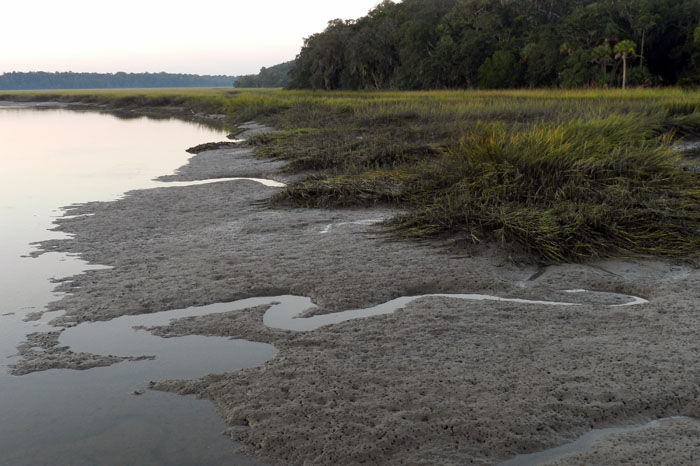 A small part of the salt marsh at Wormsloe Historic site where it abuts the maritime forest, and during low tide. See all of those holes in the foreground? I wonder what those might be?
A small part of the salt marsh at Wormsloe Historic site where it abuts the maritime forest, and during low tide. See all of those holes in the foreground? I wonder what those might be?
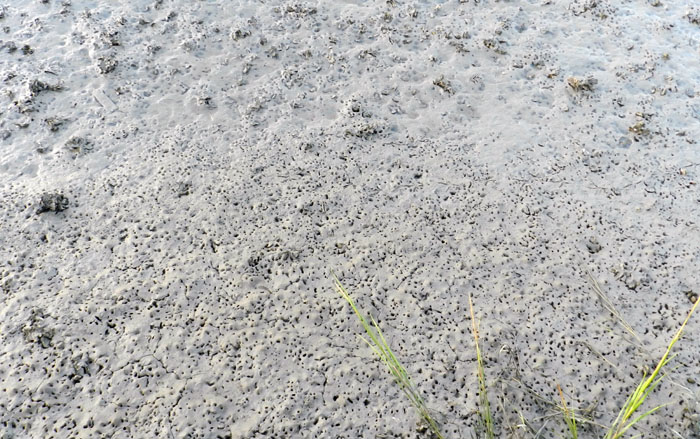 Each and every one of these holes is the burrow of a small marine-adapted animal – fiddler crabs, polychaete worms, and more. In other words, an ichnologist’s dream come true. (Photos by Anthony Martin.)
Each and every one of these holes is the burrow of a small marine-adapted animal – fiddler crabs, polychaete worms, and more. In other words, an ichnologist’s dream come true. (Photos by Anthony Martin.)
Less than a hundred meters from this dock is the home of Craig and Diana Barrow. Mr. Barrow is the ninth-generation heir of Wormsloe, but donated its grounds to the state of Georgia so that it could become a natural laboratory for researchers studying its environmental history. Ruth and I were acquainted with the Barrows from two previous visits to Wormsloe, and Craig – a great outdoors enthusiast – had eagerly given us personal tours of the woods, fields, and marshes on the property.
Having hunted for most of his life, Craig is a good tracker, and we’ve had in-depth discussions on animal-track forms, trackway patterns, aging of tracks, scat, and related topics. I find these conversations refreshing. Academic hierarchies, journal articles, impact factors, grant amounts, and other dull concerns become meaningless when you’re in the field with experienced naturalists. Here are some traces. Let’s learn.
Thus as the dawn light started to illuminate the maritime forest, I was not surprised to see Craig already outside his home, and to have him enthusiastically invite me to hop onto a golf cart with him to go look for tracks. He had already been out earlier on one of the sandy roads near his house and spotted three red foxes, so he wanted to check on whether their tracks were there, too. Within minutes, we arrived at the spot where he saw the foxes, and we quickly confirmed his sighting by identifying their fresh tracks in the loose sand on the road.
That was also about when Craig asked me a question that I answered wrong at first, then corrected once I gathered more data. You know, like any good scientist should. His question was “What’s this?”, and he was referring to a thin, shallow, and meandering groove in the sand. “Beetle trackway,” I answered instantly, without looking too closely. Then I squatted to show him the tiny tracks that would be on each side of the groove, where I imagined the beetle had dragged its abdomen.
 Oh look, a beetle trackway, and right next to the tracks of a red fox (Vulpes vulpes)! How exciting! Gee whiz, I gosh-darn love science! Isn’t it neat? Wait a minute: what’s that earthworm doing at the end of a beetle trackway? (Photo by Anthony Martin, taken at Wormsloe Historic Site.)
Oh look, a beetle trackway, and right next to the tracks of a red fox (Vulpes vulpes)! How exciting! Gee whiz, I gosh-darn love science! Isn’t it neat? Wait a minute: what’s that earthworm doing at the end of a beetle trackway? (Photo by Anthony Martin, taken at Wormsloe Historic Site.)
That’s when I realized there were no tracks on either side of the groove. This was a trail made by a legless animal. “Wait a minute, this isn’t from a beetle,” I said. “Maybe a worm?” And by “worm,” I meant earthworm, but my small amount of experience with identifying earthworm traces made me a little uncomfortable with elaborating further on that idea. After all, I didn’t want to appear too ignorant about such common animals, and ones I had written about in both my book and on this blog (Of Darwin, Earthworms, and Backyard Science and Darwin, Worm Grunters, and Menacing Moles).
Fortunately, an earthworm saved me from further embarrassment by having the decency to be at the end of one of these trails, moving and otherwise actively demonstrating how these traces had been made. With our eyes and brains properly (and instantly) trained by this association between trace and tracemaker, Craig and I glanced around us. We were rewarded for looking, and promptly became astonished. The road was criss-crossed with hundreds of earthworm trails for as far as we could see, and most of them had living worms at their ends.
Even better, a few of these trails connected to open, small-diameter vertical burrows. My second insect-biased mistake of the morning was to initially identify these burrows as the shafts of halictid bee burrows. However, too many earthworm trails connected directly to these holes. Again, like any good scientist should in the face of contradictory evidence, I changed my mind. These traces were also from earthworms, and showed where the earthworms exited their subterranean homes.
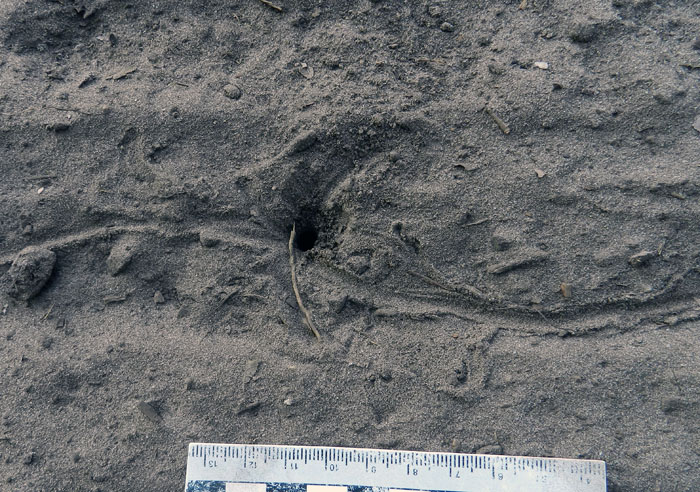 Earthworm burrow marking exactly where it left its home for the surface world, and intersecting a trail. (Photo by Anthony Martin, taken at Wormsloe Historic Site.)
Earthworm burrow marking exactly where it left its home for the surface world, and intersecting a trail. (Photo by Anthony Martin, taken at Wormsloe Historic Site.)
What really surprised me, though, was the length and complexity of the trails. These were not simple meandering paths, but complicated records of earthworm decision making. These worms may have been slow, but their traces certainly weren’t dull.
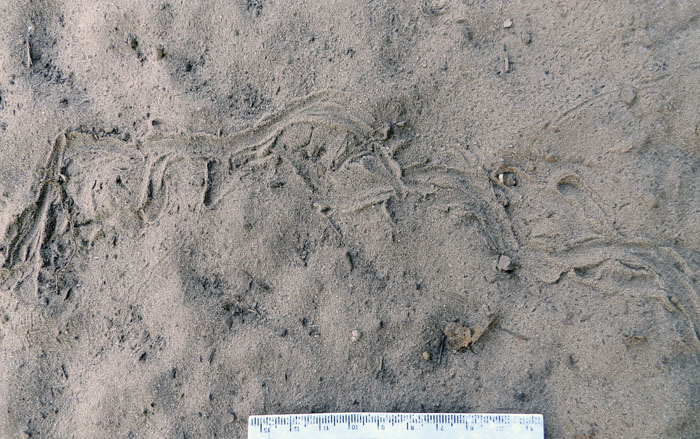 This trail was made by one earthworm that moved from right to left. The pointed grooves on either side of the main trail are from where its “head” and “tail” ends probed the sand.
This trail was made by one earthworm that moved from right to left. The pointed grooves on either side of the main trail are from where its “head” and “tail” ends probed the sand.
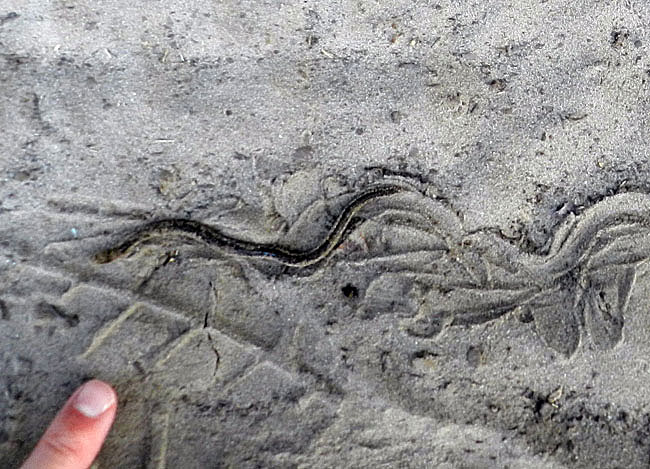 Here’s an earthworm in action, moving from right to left. Compare this to the next photo to see how movement of both its forward and rear ends changes the trail, putting newer traces on top of the previously made ones.
Here’s an earthworm in action, moving from right to left. Compare this to the next photo to see how movement of both its forward and rear ends changes the trail, putting newer traces on top of the previously made ones.
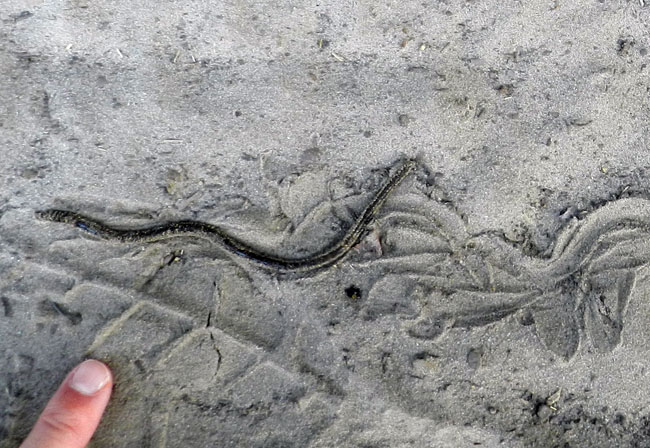 See what I mean? Small but multiple movements from both ends of a worm – as well as its middle – make this much, much more than just a “worm trail.” So don’t be calling it that. (Photos by Anthony Martin, taken at Wormsloe Historic Site.)
See what I mean? Small but multiple movements from both ends of a worm – as well as its middle – make this much, much more than just a “worm trail.” So don’t be calling it that. (Photos by Anthony Martin, taken at Wormsloe Historic Site.)
Yes, I know, there’s a bigger question that looms over all of this ichnological minutiae: Why were so many worms on top of the ground, instead of in it? What could have caused hundreds of them to leave their homes and risk the perils of dehydration and predation at the surface?
I speculated aloud that their mass stranding might have been related to vibrations imparted to the road. After all, Charles Darwin had noted how earthworms reacted like this to subsurface vibrations, associating these with their mortal enemies, burrowing moles. This was independently verified by “worm grunters” of the Appalachians, who took advantage of earthworm-mole co-evolution to get bait for their fishing. Craig backed up my idea by saying that he had grated the road the previous day. So perhaps the vibrations from his vehicle and activities had persuaded the earthworms to come up and out of the ground.
Later, though, I wondered whether another much larger stimulus had invoked such aversive reactions in the earthworms, one that persisted for more than a day after the road had been grated. What else could have done this, impelling these earthworms to flee, much like urban hipsters sensing the first few notes of a nearby Justin Bieber concert, and leaving spilled PBR’s in their wake?
Then it came to me. A full moon that weekend had caused higher tides than normal in the area, ranging from 2.6 to 2.9 m (8.5-9.6 ft). As a result, saltwater probably crept high enough in the soil profile to trigger a collective reaction in the earthworms, which do not fare well once salty water starts filling their homes. Yes, that would do it.
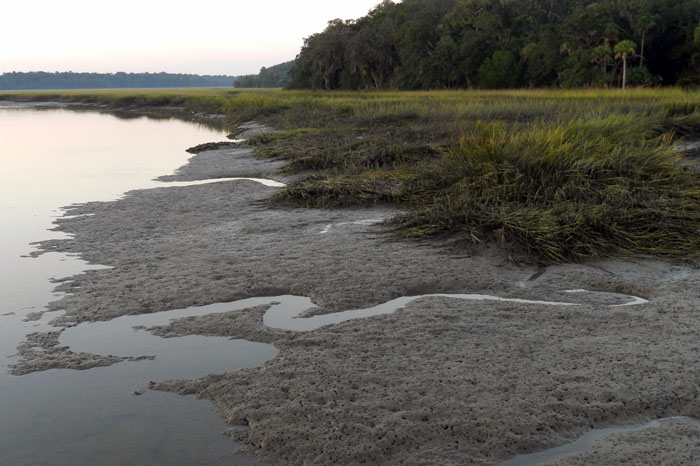 Hi, terrestrial earthworms. Remember me? I’m a salt marsh with 2.5-3 m high tides, right next to where you live.
Hi, terrestrial earthworms. Remember me? I’m a salt marsh with 2.5-3 m high tides, right next to where you live.
Assuming this hypothesis is correct, what we saw there on that sandy road of Wormsloe Historic site was a great example of a marine ecosystem forcing animals living in a terrestrial ecosystem to drastically change their behaviors. Best of all, these animals made a suite of traces that reflected this sudden change in their behaviors. If preserved in the fossil record, such trails and burrows might even be recognizable to geologists and paleontologists, some of whom are quite fond of calling every invertebrate trace fossil a “worm burrow” anyway.
All in all, this field experience at Wormsloe taught me a lesson about keeping my senses open to noticing and wondering about traces wherever I go, as should you, gentle readers. Look for those moments when the worm has turned: they will teach you something new.
